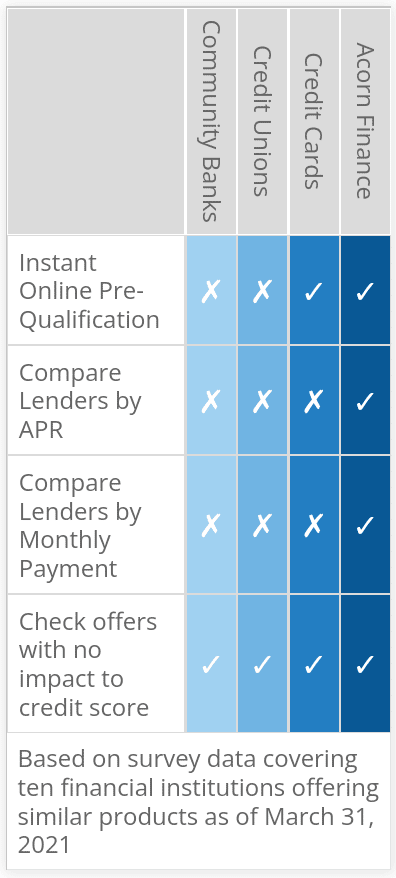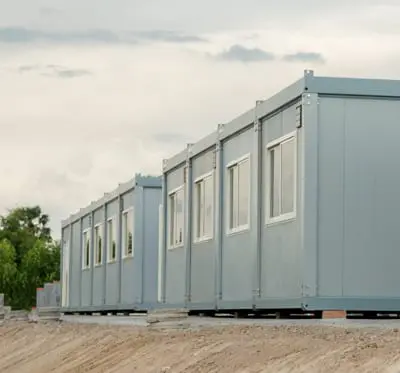Container Home Financing
Get shipping container home financing offers in 60 seconds with no impact to your personal credit score
How much would you like to finance?

Shipping Container Home Financing
Get shipping container home financing today – without impacting your credit score. If you are in the middle of a home remodel and you’re thinking of a shipping container home, or even a pole barn structure, Acorn Finance can get you the financing you need.
No matter your credit score, if you want to secure shipping container home financing in California, Texas, Colorado, or anywhere across the U.S., Acorn Finance will provide pre-qualified loans in seconds to get your new shipping container home financed quickly. Easily sort all the shipping container home loan offers by what matters to you: interest rate, payment amount, length of the loan term.
Never impact your credit score when comparing rates between our network of trusted partners. 100% online, customer-friendly process is designed to help you find affordable payment options with lenders that can quickly finance a shipping container home you want to build.
Financing for Container Homes with Acorn Finance

Pre-qualify

Select offer

Finish application

Receive funding
How We're Different
Check offers
in seconds
Won't impact
credit scores
Competitive
payment options
Receive
funds quickly
Compare Rates From Lenders in Our Network
Container Home Financing Options
Shipping container home financing is available to help make the american dream of owning your own home a reality. Keep reading to learn more about building and financing a shipping container home.
Read More
What is a shipping container home?
Shipping container homes are exactly what they sound like... a home built within a steel shipping container. At first you might reject the idea of a shipping container home, but hear us out. Shipping container homes are trending because they make an affordable, convenient, eco-friendly, and modern looking living space. In addition, the construction process is simple. You start by ordering the number of shipping containers you need and get them delivered.During production the shipping container is pre-fitted for insulation and built to be structurally sound. Since shipping containers are built in a factory setting there are strict quality standard requirements. Once your containers are delivered, the transformation can begin.
Are container homes considered mobile homes?
In most cases, shipping container homes are not considered mobile homes. While they are both an affordable and eco-friendly living solution, they have their differences. Mobile homes usually offer better insulation and can be preferred in areas that have harsh climates. Shipping containers are usually only about 8 feet wide by 8 feet tall. This means you may need more than one shipping container. Mobile homes are usually offered in a variety of sizes and styles.
Can you legally live in a shipping container?
Yes, in most states, shipping containers can be legally modified into residential units. Just like mobile homes and site-built homes, shipping container homes are required to meet building codes and zoning requirements in order to be a legal living space.
Do you need a permit to put a shipping container on your property?
Whether you need a permit or not for a shipping container home depends on where you are located. If you are using the storage container as a residential unit the chance of needing a permit can increase.
What states allow container homes?
In most states shipping container homes are legal. Any state or city that is not allowing them yet, should be seriously considering allowing shipping container homes. You should contact your city or county planner to find out about local regulations for shipping container homes. If you have confirmed your area allows shipping container homes, you will want to verify regulations. Regulations can vary from county to county. To verify regulations you can contact a local building authority. Some states that allow shipping container homes include Texas, California, Louisiana, Tennessee, Alaska, Missouri, and Oregon. For more information on local acceptable codes and state standards you can visit the International Code Council (ICC) online. The ICC regulates building codes and can provide specific mandatory requirements that must be net before permits are issued. Similar to traditional residential and commercial apartments, zoning laws apply to shipping container homes in most areas. Before approaching local authority you should determine the kind of structure you wish to build. Once you have confirmation that shipping container homes are allowed in your area, you can approach local authority for a building permit.
How do you insulate a container home?
Insulating a shipping container home is an important step toward making it a sustainable living space. Without insulation, shipping container homes can still provide shelter and a place to call home but they may feel like a hot sticky box or harsh cold box, depending on the weather. While shipping container homes can be insulated, there are a few challenges. The primary challenge is that walls' inherently shallow depth. So how do you insulate a shipping container home?
#1. Build out the walls
One way to resolve the problem is to build the walls out to the proper depth. This process can be similar to finishing a basement. The downside to this process is you may lose valuable square footable inside your shipping container home. This option is most suitable for larger shipping container homes.
#2. Insulate the exterior
If you are building a tiny shipping container home (one or two shipping containers) you may want to add insulation to the exterior and cover it with exterior cladding instead. If you go this route, interior walls can be left as exposed metal or covered with interior plaster for a more homey feel.
#3. Spray foam insulation
Spray foam insulation is a quick and easy way to insulate a shipping container home but it may not be the most sustainable. In addition, the EPA has highlighted potential health hazards related to the spray insulation. Another downside to this option is that not all spray foam is there can be variances in spray foam. Some spray foams may be harmful to the atmosphere. If you are going to use spray foam insulation you should find a product with expansive properties such as closed-cell foam. They may be more expensive upfront but can save you money in the long run.
#4. Wool insulation
Wool insulation is a high-performance and environmentally friendly alternative for container home insulation. Sheep's wool has lanolin which is naturally flame retardant so you'll want to treat wool with other chemical solutions.
#5. Cotton insulation
Cotton insulation is often recycled, thus encouraging container homeowners to use it. While this may be an environmentally friendly option, it does require a vapor barrier. If cotton insulation gets wet it can lose some of its insulation properties.
Do shipping container homes need a foundation?
Shipping container homes need a foundation! If your shipping container home does not have a proper foundation you may experience costly problems down the road. As the ground moves over time, it can cause your shipping container home to no longer be level. It can even cause shipping container homes to split or separate if there are multiple containers attached. Building a solid foundation can help you avoid these problems and more. It can also help prevent moisture. Moisture can cause corrosion – a problem you'll want to avoid. If the shipping container home is temporary or will be moved within a few months, you may be able to use railroad ties.
How much would it cost to turn a shipping container into a house?
Larger shipping container homes can cost between $150,000 to $175,000 to build. However, if you are experienced and handy you can build a shipping container home for about $10,000+. There are a lot of factors that can influence the cost such as size, location, insulation, design features, and more.
Compared to the cost per square foot of traditional stick building, shipping container homes can cost half as much. In addition, if well-maintained shipping container homes can retain resale value. Before building a shipping container home you should consider climate conditions. Making sure your shipping container home is built properly for climate conditions can help it retain resale value.
How much does a 40 foot shipping container cost?
Shipping containers can be purchased in new or used condition. You can expect the pricing of used shipping containers to vary based on age, condition, delivery fees, and so on. According to Container Discounts, a new 40-foot shipping container can cost about $4,500 and a used 40-foot container can cost about $2,200. These are ballpark figures but should provide a rough idea of cost. Shipping containers are designed to be durable and can last for decades. Since it's likely that you'll be doing interior and exterior modifications, a used shipping container may be more than suitable.
Where are shipping container homes legal?
In most states shipping container homes are legal. Any state or city that is not allowing them yet, should be seriously considering allowing shipping container homes. You should contact your city or county planner to find out about local regulations for shipping container homes.
What adjustments must be made to a shipping container to live in?
Building a shipping container home can be easier than building a tiny home because the shell is already there. Once you order and receive your container or containers it's time to transform them into your desired living space. Let's look at some of the steps involved in transforming a shipping container into a home...
#1. Design your space
Before starting any construction you should sit down and decide how to make your shipping container(s) a functional living space. Where do you want the windows? Where do you want the bedrooms? Do you want a loft? How should your containers connect? Even though you may have a small space, the design potential is unlimited.
#2. Consult an engineer & finalize your design
If you plan on removing or adding walls you should consult an engineer to ensure your container will remain structurally sound. Once you have your plans confirmed as safe, you can finalize your design.
#3. Prepare your land
Once you have selected where your shipping container home will go, you should prepare the land. The land should be leveled with a foundation for the container. Make sure you have a clear path for the containers to be delivered safely.
#4. Choose, buy, receive, and connect your shipping containers
This is an important step. After you select and purchase your containers they should be delivered. After they have been delivered it's time to connect the containers, assuming you ordered more than one. If your design requires any structural reinforcements they should be added during this step as well.
#5. Cut your openings
Once your containers are connected it's time to start cutting our windows, doors, and other parts of the walls. This is an exciting step where you can really start to see your design vision coming to life.
#6. Remove flooring
Most people prefer to remove the flooring of their shipping container home because it's been treated with harsh chemicals. If you wish to protect yourself and remove the factory floor you should do it before moving onto the next step.
#7. Frame, sheath, and add the floor and the insulation
During this step you should add your frame and insulation. The type of insulation you use can vary depending on where you live. If you remove the floor you will want to install your new flooring.
#8. Add electric, decorate, and move in
This step is pretty self explanatory... add your finishing touches and move in. Welcome home!
How much does it cost to finance a container home?
Larger shipping container homes can cost between $150,000 to $175,000 to build. However, if you are experienced and handy you can build a shipping container home for about $10,000+. There are a lot of factors that can influence the cost such as size, location, insulation, design features, and more.
How long do container homes last?
Shipping containers are made out of steel, which is very durable. In most cases, shipping container homes can last 25 years without needing any major maintenance.
Do container homes appreciate in value?
Surprisingly, yes, container homes usually retain or appreciate in value.
Will banks finance shipping container homes?
Financing options can be limited for shipping container homes. Most banks choose not to lend funds for a property that is not fixed to a permanent location. Personal loans can be one of the best options for financing a shipping container home. You can pre-qualify for a personal loan using an online lender, bank, or credit union. Online lenders can offer a faster and easier process while still delivering competitive rates and high loan amounts. Acorn Finance offers personal loans for shipping container home financing for all credit types.
Can you get a mortgage on a container home?
You may be able to get a mortgage on a container home if it's built in compliance with single family home building codes. However, not all container homes are considered real estate. In order for a container home to be considered real estate it should be built on a permanent foundation with utility hookups. Some lenders may be apprehensive to provide a mortgage for a container home as they may question the legitimacy. If you want to obtain a mortgage for a container home you should work with a professional contractor and present the lender with construction plans. A personal loan may be an easier option when it comes to container home financing but mortgages may offer lower interest rates and other perks. It may be worth your time to look into both options to determine what you can qualify for.
Are container homes a good investment?
If built and maintained properly, container homes can be a good investment. In addition, purchasing land to build a container home on can be a good investment. The upfront cost to build a shipping container home is usually much cheaper than a traditional home. The maintenance cost of a container home may also be cheaper than a traditional home. Container homes can provide an affordable and sustainable living space that can provide a good return on investment.
Do container homes hold value?
A container home can hold value and be rented or resold similar to a traditional home. To help ensure your shipping container home retains value you should make necessary modifications to make it appropriate for its intended location.
Can you get a shipping container home with bad credit?
If you are looking to finance a new home construction using shipping containers, you have many different options to consider. If you have bad credit, some of those options may be better than others, however, you should complete a full cost-benefit analysis to help you determine which course of action would be best for your financial and credit situation.
If you want to finance the construction of your shipping container home through a traditional mortgage, that may be an option you can pursue, however, some lenders might refuse to finance a shipping container home because they are afraid that they might not retain and build value like a traditional home would. Tiny houses, including shipping containers, sometimes depreciate rather than build equity. That may scare off some lenders from financing your shipping container home with a traditional mortgage, however, there are still plenty of options available to you.
You could explore options like an unsecured or secured personal loan, a home equity loan or home equity line of credit (if you already own a property), or even a loan directly through the manufacturer in some circumstances. You can also pursue an FHA loan to fund the entire construction and overall cost of your new shipping container home. Either way, you will want to look over all your options to ensure you are choosing a method of financing that will keep overall costs down and not saturated with interest payments and other applicable fees.
An FHA loan is a government-backed mortgage that you can qualify for when you have bad credit and you are unable to qualify for a traditional mortgage. Some people use FHA loans even if they can qualify for a traditional mortgage because they require a much lower down payment. Down payments on a traditional mortgage can be upwards of 20% or more. AN FHA loan only requires a down payment of either 3.5% or 10% depending on your credit score. If you gave a credit score of 580 or above, then a down payment of only 3.5% will suffice. The United States government will back the remaining 96.5% of your overall home's value. If your credit score is 579 or lower, then you will need to come up with a down payment of at least 10%.
Most shipping container home construction projects can be entirely financed with a personal loan. Shipping container homes typically are classified as tiny homes, and if costs can remain below $100,000, then you may want to consider financing your shipping container home using a personal loan.
By using a secured or unsecured personal loan to finance a new shipping container home you can make sure you have the freedom to make changes during the construction process. When you take out a personal loan, the lender does not have a say in how you use the money. Once you qualify for a personal loan and you receive the funds, you are free to use the money however you want and then you are simply required to make monthly payments in return. That will give you the freedom you need along the way to make sure you construct the shipping container home that you have always wanted. Use the funds from a personal loan to purchase land, purchase the shipping containers, and to gather the professionals you need to assist you to complete your project.
Can you finance a shipping container home with bad credit?
Yes, financing a shipping container home with bad credit is entirely possible. You may have to take a few different approaches based on your credit situation, however, obtaining a personal loan to build a shipping container home is a path you may choose. Ideally, you will want the highest credit score you can in order to qualify for personal loans with the best interest rates and the lowest fees.
The higher your credit score is above 700, the better. People with excellent credit, credit scores that reach 800 or above, will find that they can potentially qualify for personal loans with some of the lowest interest rates. They will also most likely not have to pay an origination fee to acquire the financing. But, not everyone can have a credit score above 800. If you have bad credit, you should know that you still have a good chance to qualify for a personal loan. The only downfall is that you will pay much higher interest rates than someone who has a credit score above 800. Additionally, you may be required to borrow more in order to cover any origination fees that a lender may charge.
Can you finance a shipping container with a 600 credit score?
Although it is heavily recommended that you have a credit score of at least 610 to apply for a personal loan, many lenders out there are still willing to consider financing a personal loan with a credit score of 600. To increase your chances of qualifying, you should make sure you do not have too many other outstanding debts when you apply. You may want to consider paying off any other loans or paying down the balance on your credit cards to make sure your debt-to-income ratio is as high as possible. Lenders will be looking closely at where you have your money tied up. They will also be looking at your income carefully, so if you have any additional income that you make from a side-job, make sure you include all taxable income when you are applying. If you have a high debt-to-income ratio, and a credit score of 600, a lender may require you to have a co-signer or to secure the loan with collateral. A co-signer is someone who will be held responsible for payments if you should fall behind on your loan. They will also face the same credit issues that you face if they are unable to make the payments on your behalf. This is why, if you do go the route of a co-signer, you should be absolutely sure you will be able to take on the monthly payments and to never fall behind.
If you go the route of a secured loan, make sure you stay up on the payments or you risk the chance of losing whatever your collateral is. It is recommended that you do not use your primary vehicle to secure a loan, however, it could be an option if you know you will be able consistently make the payments. You do not want to fall behind on payments and potentially risk losing your only source of transportation. You may consider using another vehicle like an RV or a boat as collateral, or even use family heirlooms or an object that has tangible financial value.
What credit score is needed to finance a new shipping container home?
The credit score that you will need to qualify to finance a new shipping container home depends on what time of financing you go after. If you find a lender who is willing to finance your shipping container home with a traditional mortgage, then lenders most likely will want to see a minimum credit score of 620. If you do apply for a conventional mortgage with a credit score of 620, lenders are going to be extremely picky about your income, your existing debts, and may even look to see your checking account information to get an idea of your spending habits.
FHA loans will require a downpayment and a credit score of at least 500 to be considered. Personal loan lenders will likely want to see a minimum credit score between 610 and 640.
Do you need to check credit to get shipping container home financing?
In most cases, you will need a credit check to secure financing for a shipping container home. If a lender is offering no credit check financing for a large loan amount, be cautious.
How long can you finance a shipping container home for?
The loan term will depend on the type of loan and the lender. If you use a personal loan, you may be able to find terms up to 12 years. If you use a traditional mortgage you may find terms up to 30 years.
Can you insure a container home?
While it may be difficult to insure a container home, it's not impossible. However, you should have insurance on a container home. As container homes gain popularity more and more insurance companies are creating policies to insure them. They are often insured based on housing and safety standards. Whereas a traditional home is typically insured based on size. Shipping container homeowners in hurricane prone areas can benefit from the strength and stability their container home provides. Container homes have been known to withstand hurricanes, thus decreasing the chance of needing to file an insurance claim. Intermodel Steel Buildings (ISBU) are known for outstanding safety and fire ratings. ISBU buildings may be easier to insure.
How Does Acorn Finance Compare?
Compare Rates From Top Lenders








$25000 Loan Calculator
Are You A Contractor?
Stop letting container home financing deals slip through your fingers.
Close more sales with easy, affordable shipping container financing options for your customers
Get StartedPopular Home Improvement Projects
Barn Financing Options
One home, endless possibilities




